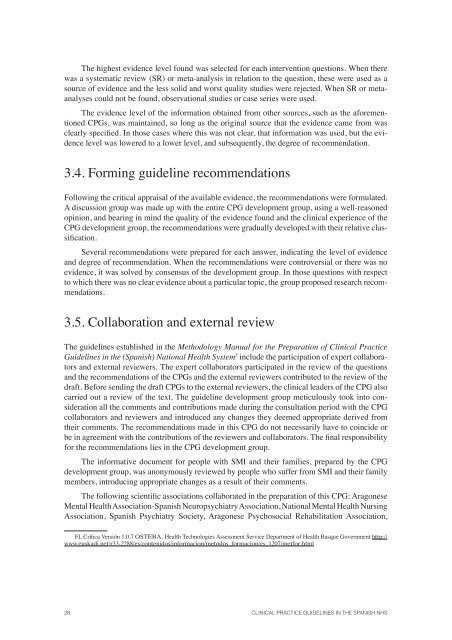CPG for Psychosocial Interventions in Severe Mental ... - GuÃaSalud
CPG for Psychosocial Interventions in Severe Mental ... - GuÃaSalud
CPG for Psychosocial Interventions in Severe Mental ... - GuÃaSalud
You also want an ePaper? Increase the reach of your titles
YUMPU automatically turns print PDFs into web optimized ePapers that Google loves.
The highest evidence level found was selected <strong>for</strong> each <strong>in</strong>tervention questions. When there<br />
was a systematic review (SR) or meta-analysis <strong>in</strong> relation to the question, these were used as a<br />
source of evidence and the less solid and worst quality studies were rejected. When SR or metaanalyses<br />
could not be found, observational studies or case series were used.<br />
The evidence level of the <strong>in</strong><strong>for</strong>mation obta<strong>in</strong>ed from other sources, such as the a<strong>for</strong>ementioned<br />
<strong>CPG</strong>s, was ma<strong>in</strong>ta<strong>in</strong>ed, so long as the orig<strong>in</strong>al source that the evidence came from was<br />
clearly specified. In those cases where this was not clear, that <strong>in</strong><strong>for</strong>mation was used, but the evidence<br />
level was lowered to a lower level, and subsequently, the degree of recommendation.<br />
3.4. Form<strong>in</strong>g guidel<strong>in</strong>e recommendations<br />
Follow<strong>in</strong>g the critical appraisal of the available evidence, the recommendations were <strong>for</strong>mulated.<br />
A discussion group was made up with the entire <strong>CPG</strong> development group, us<strong>in</strong>g a well-reasoned<br />
op<strong>in</strong>ion, and bear<strong>in</strong>g <strong>in</strong> m<strong>in</strong>d the quality of the evidence found and the cl<strong>in</strong>ical experience of the<br />
<strong>CPG</strong> development group, the recommendations were gradually developed with their relative classification.<br />
Several recommendations were prepared <strong>for</strong> each answer, <strong>in</strong>dicat<strong>in</strong>g the level of evidence<br />
and degree of recommendation. When the recommendations were controversial or there was no<br />
evidence, it was solved by consensus of the development group. In those questions with respect<br />
to which there was no clear evidence about a particular topic, the group proposed research recommendations.<br />
3.5. Collaboration and external review<br />
The guidel<strong>in</strong>es established <strong>in</strong> the Methodology Manual <strong>for</strong> the Preparation of Cl<strong>in</strong>ical Practice<br />
Guidel<strong>in</strong>es <strong>in</strong> the (Spanish) National Health System 5 <strong>in</strong>clude the participation of expert collaborators<br />
and external reviewers. The expert collaborators participated <strong>in</strong> the review of the questions<br />
and the recommendations of the <strong>CPG</strong>s and the external reviewers contributed to the review of the<br />
draft. Be<strong>for</strong>e send<strong>in</strong>g the draft <strong>CPG</strong>s to the external reviewers, the cl<strong>in</strong>ical leaders of the <strong>CPG</strong> also<br />
carried out a review of the text. The guidel<strong>in</strong>e development group meticulously took <strong>in</strong>to consideration<br />
all the comments and contributions made dur<strong>in</strong>g the consultation period with the <strong>CPG</strong><br />
collaborators and reviewers and <strong>in</strong>troduced any changes they deemed appropriate derived from<br />
their comments. The recommendations made <strong>in</strong> this <strong>CPG</strong> do not necessarily have to co<strong>in</strong>cide or<br />
be <strong>in</strong> agreement with the contributions of the reviewers and collaborators. The f<strong>in</strong>al responsibility<br />
<strong>for</strong> the recommendations lies <strong>in</strong> the <strong>CPG</strong> development group.<br />
The <strong>in</strong><strong>for</strong>mative document <strong>for</strong> people with SMI and their families, prepared by the <strong>CPG</strong><br />
development group, was anonymously reviewed by people who suffer from SMI and their family<br />
members, <strong>in</strong>troduc<strong>in</strong>g appropriate changes as a result of their comments.<br />
The follow<strong>in</strong>g scientific associations collaborated <strong>in</strong> the preparation of this <strong>CPG</strong>: Aragonese<br />
<strong>Mental</strong> Health Association-Spanish Neuropsychiatry Association, National <strong>Mental</strong> Health Nurs<strong>in</strong>g<br />
Association, Spanish Psychiatry Society, Aragonese <strong>Psychosocial</strong> Rehabilitation Association,<br />
FL Crítica Versión 1.0.7 OSTEBA. Health Technologies Assessment Service Department of Health Basque Government http://<br />
www.euskadi.net/r33-2288/es/contenidos/<strong>in</strong><strong>for</strong>macion/metodos_<strong>for</strong>macion/es_1207/met<strong>for</strong>.html<br />
28 CLINICAL PRACTICE GUIDELINES IN THE SPANISH NHS

















